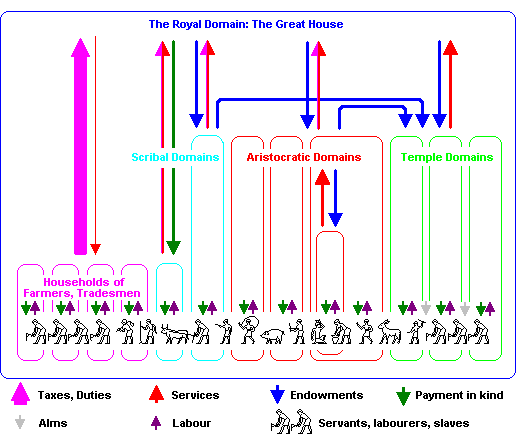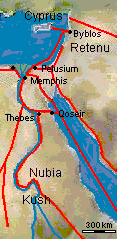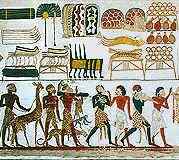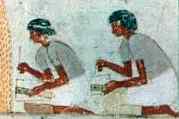A considerable amount of wealth was invested in the building of tombs and the services following burial, which were supposed to go on for ever.
Quarrying on the other hand was always done by Egyptian craftsmen supported by draftees to perform the unskilled labour and soldiers for protection, generally in the form of expeditions.[Back]
Source: Lionel Casson,Ancient Egypt- Time-Life Books
APIS Advanced Papyrological Information System
S.Allam,Hieratische Ostraka und Papyri aus der Ramessidenzeit, Tbingen 1973
depended to some extent on the labour and expendability of slaves, above all during the New Kingdom, when warfare and trade greatly increased the number of enslaved foreigners.
Feedback: Please report broken links, mistakes – factual or otherwise, etc. tome. Thanks.
Egypt, Retenu and Nubia: Major trade routes
Cf. the main article on taxation:Dues and duties
Piscicultureappears to have have existed on a very small scale. But practically all thefishconsumed were caught in the Nile.Hunting, a leisure activity to the rich, and gathering played a small economic role over all, but may have been crucial to the survival of the poorest.A large part of the manufactured goods came from the families which produced the raw materials. Labour was divided according to gender, with the processing generally left to the women. While the men grew flax, their women spun it into thread and wove thelinen. A sizable proportion of the grain produced was used forbeerproduction. Thefishcaught by the men had to be cleaned and dried, which was generally done by women, to be of much use in the hot climate of Egypt, unless they were consumed immediately.
Duties: taxation, forced labour, military service
was exploited only byshipsand even there quite inefficiently: The square sails used enabled only sailing before the wind. The Egyptians were fortunate in that the Nile flowed from south to north. The prevailing winds were northerly and sufficed to blow the ships upriver. They were let to drift downriver with furled sails. But often a destination could only be reached through rowing which required large crews.
Natron needed for the embalming process, was mined in the Wadi Natrun. Embalming was too expensive for all but a few.
Since the second half of the first millennium BCE gold, silver, and copperin speciewere used mostly in dealings with foreigners, be they mercenaries or merchants.
The practice ofslaverywas practically ubiquitous in ancient times. In Egypt it was seemingly less harsh and widespread than in other societies. Still, some branches of the economy like mining
Brian P. Muhs,Tax Receipts, Taxpayers, and Taxes in Early Ptolemaic Thebes, Oriental Institute Publications, University of Chicago, 2005
Peasant villagers, on the whole the poorest segment of the population, hardly ever travelled far and their knowledge of what lay beyond their own community was limited. They came into contact with low ranking scribes and overseers, who were not much better off than they themselves. But by thrift and hard work they could hope to gain additional property and rise on the social ladder.In a society where precious metals were not considered a special means of exchange and were mostly in the hands of the pharaohs and the temples, wealth was synonymous withpossession of land.
Much of thetradebeyond local exchanges is thought to have been in the hands of wholesale merchants acting for the crown or the great temple estates. The extent to which private individuals were involved in trading cannot be estimated. Market forces seem to have played a role above all during the periods when the administration broke down.
Still, there was a specialized bureaucracy which monitored or controlled much of its activity, one of the hallmarks of planned economies. On the other hand, in general the officialsas state employees and not as private landowners or managers of state farmsprobably did not tellfarmerswhat to grow and these continued to do what their predecessors had done. But they remeasured and reassigned the land after every inundation based on past assignments, assessed the expected crops, collected part of the produce as taxes, stored and redistributed it to those on the states pay lists. Storage and redistribution were generally done on a local basis. Regional facilities provided produce in case there was a shortfall in one of the local centres.
For best results save the whole webpage (pictures included) onto your hard disk, open the page in Word 97 or higher, edit if necessary and print.
Estimates of ancient population figures are mostly more or less educated guesses.Bagnall and Friers estimate of the urban population in the first centuries CE amounts to 37%, making Roman Egypt the most urbanized society of its day; others like Scheidel think it was less than a quarter. [Back]
Kurt Sethe,Urkunden der 18. Dynastie Band I, J. C. Hinrich, Leipzig, 1914
J. H. Breasted,Ancient Records of Egypt, 5 volumes
Highinterest ratesdid not encourage commerce and during the first millennium BCE they may well have put Egyptian merchants at a disadvantage vis–vis foreign traders who were funded from abroad. During the Saite Period monthly interest rates could reach 10%.The main energy source of ancient times wasmuscle powerprovided to a large extent by humans, butdomesticated animalsplayed an important role. The animals used in agriculture were donkeys for transporting produce and cattle for ploughing and other heavy work. Harnessing was inefficient. The yoke resting on the animals shoulders was unknown, and the shafts of the ploughs were fastened to the horns of the cows.
Bravery in battle wasrewardedwith appointments, decorations in the form of golden necklaces and bracelets, and gifts of land and slaves, part of the booty plundered from vanquished enemies. Tribute was imposed on defeated nations and the exchange of gifts between the pharaohs and the kings of client states was generally in Egypts favour.
R.S. Simpson, Demotic Grammar in the Ptolemaic Sacerdotal Decrees (Oxford, Griffith Institute, 1996)
The Egyptian Economy and Non-royal Women: Their Status in Public Life
Unlike the much vaunted empire of the New Kingdom in the Levant, which was mostly a string of subject states in Lower Retenu run by local potentates, Nubia and Kush, the important conquests in the south, were closely integrated into the Egyptian culture. LowerNubiaat least was directly ruled and exploited by the Egyptians for most of the second millennium BCE. Its importance as supplier of gold, slaves and luxury goods was underlined by the appointment of vice-roys to rule Kush directly. No other region conquered by Egypt was economically and culturally as dependent, nor retained this affinity for centuries after Egypts power had declined in the first millennium BCE.
In the towns small factories appeared, often financed by rich noblemen: bakeries, breweries, carpentry workshops and the like with a few dozen employees. In these manufactories weaving, for instance, became a largely male occupation with the introduction of upright looms during the New Kingdom.Most of the thingsminedwere of little interest to anyone but a small number of rich people. Precious metals were not in general circulation until the Late Period and even then remained in the hands of few. The metals used fortools-copper, bronze and, from the Late Period onwards, iron- were expensive and the implements fashioned from them were beyond the reach of many. Poorer people continued to usestone and wooden toolsfor most purposes well into theBronze and even beyond into the Iron Age. Gems too remained in the possession of a wealthy minority and the stonequarriedfor temples and tombs served the same class of people and profitted only the craftsmen involved in building.
Some of the wheat harvested and belonging to private owners was stored in state warehouses. So was much of the grain collected as taxes. Written withdrawal orders by owners of lots of grain were used as a kind of currency. These grain banks continued to serve growers and traders even after theintroduction of coined moneyin the latter half of the first millennium BCE. Under thePtolemiesa central bank at Alexandria recorded all accounts of the granary banks dotting the country. Payments were transferred from account to account similar to the modern giro system. Credit entries were recorded with the owners name being in the genitive or possessive case and debit entries in the dative case.
Theheat of the sunon the other hand was put to very good use in the production ofmud bricks, which were the perfect building material in a practically rainless country like Egypt.Military ventures can be a source of income – as long as one is successful. Egypt was fortunate in this respect until the Late Period, when it came under the domination of foreign powers. What began with relatively benign occupations by theLibyans,Kushites,AssyriansandPersians, would become oppressive under the Roman Empire, which exploited its provinces ruthlessly. The attempts ofCleopatra VIIto retain independence were unsuccessful and the country fell prey to Octavian. For as long as Rome ruled the Mediterranean, Egypt was little more than its bread basket.
Bagnall, Roger S.; Frier, Bruce W. ;The Demography of Roman Egypt, Cambridge University Press, 1994

Scheidel,Death on the Nile: disease and the demography of Roman Egypt, Brill 2001
one of the other causes being the climate.
Ancient Egypt is considered by some to have been the most heavily taxed nation and to have collapsed under the weight of the levies imposed on the populace. But, with a few minor interruptions, its society existed peacefully and basically unchanged for more than two millennia. Even in its days of decadence Herodotus thought it provided better living conditionsif health is anything to go bythan most others he had seen,
The gods had to be propitiated by offerings and rituals celebrated by great numbers of priests. To maintain this clerical establishment large parts of Egypt were donated to the temples. By the New Kingdom they appear to have owned as much as a third of the arable land and were exempt from paying taxes. Even the people in their employment were protected by law against impressment. This concentration of wealth may have contributed to the decline of the state under the 20th dynasty.
Lionel Casson,Ancient Egypt, Time-Life Books
J. Kraus,Demographie des alten gypten, 2004
Sten V. Wangstedt,Ausgewhlte demotische Ostraka aus der Sammlung des Victoria-Museums zu Uppsala und der Staatlichen Papyrussammlung zu Berlin, Uppsala 1954
The cashless society and womens place in it
Of course, different classes of people benefitted to different degrees, but care was taken not to leave too many people with nothing to lose, a lesson the Spartans and the Romans for instance never learned. While famines affected the poor much more than the rich, in normal times there was not that much difference as regards health, survival of ones children or even longevity.
T.G.H.James,Pharaos Volk, Artemis Verlag Zrich und Mnchen , 1988
These are just suggestions for further reading. I do not assume any responsibility for the content or availability of these sites.

Theoretically all the land belonged to the pharaoh who could dispose of it at will. Large tracts were given to the military, above all during times of unrest when the kings needed their support and were unable to recompense them in any other way. Officials were also beneficiaries of such royal munificence. But most of the land came to be owned outright by the temples and the peasantry.
Juan Carlos Moreno Garca, 2008, Estates (Old Kingdom), in Elizabeth Frood and Willeke Wendrich (eds.)UCLA Encyclopedia of Egyptology, Los Angeles,
Bureaucrats were also in charge of public works which were mostly religious in character and involved at times tens of thousands of workers and administrators.
Thanks to the yearly inundations the soil remained fertile. But agricultural techniques were not very efficient. Improvements were rare, implements remained primitive and the breeding of better livestock was haphazard.
Firewas needed for cooking and bakingfood,smelting and casting metal,glassmaking,burning potteryand very rarely for makingbricks. For the working ofmetalshigh temperatures had to be achieved and this was done quite possibly with charcoal. No coal was available in ancient times and wood was not very plentiful. One suspects that ordinary fires were fed with any dry vegetable or animal matter that was at hand.
Peter van Minnen,Ancient Society30, 2000
Agriculturecreated most of Egypts wealth. Grain, vegetables, fruit, cattle, goats, pigs and fowl were grown, and fish from the Nile were caught, and eventual surpluses, after deduction of the various taxes, were sold on the markets.
Egypt was a patchwork of mostly autarkic households and domains. After the taxes were paid, domain administrators and successful householders stored surpluses for future use or exchanged them by barter on themarket, an institution the nature of which is remarkably badly understood. The percentage of produce and even manufactured goods which reached markets was probably small. It may have been of marginal importance to the survival of the individual producer, but provided part of the economic base for the developing Egyptian high culture.
The economy of pharaonic Egypt has been called an ancient command economy, but one should always remember that such modern definitions are not as apt as one would hope for.

Acta Universitatis Upsaliensis- Boreas Vol.6, 1974
S. Birch,Records of the Past, Series 1, Vol.VIII, 1876, Samuel Bagster and Sons, London

… they think that all the diseases which exist are produced in men by the food on which they live: for the Egyptians are from other causes also the most healthy of all men next after the Libyans.
Tribute brought before Ramses II, excerpt
Jacob Rabinowitz,Isle of Fire, Invisible Books, 2004
Apart from the tenant peasants, a large section of the population worked as farm labourers on the estates of noblemen and of the temples. During the New Kingdom perhaps a third of the land was in the hands of theAmen priesthood, with a proportionally large number of workers andslaves.
The state relied on revenues in the forms of labour andtaxespaid in kind. Grain was the most important produce hoarded by the authorities, as it could be stored with relative ease and was vital in years of bad harvests.A major part of the levies imposed on the people was used to stabilise society. A bureaucratic administration, at first native and in the Late Period increasingly foreign, enforced order throughout the country during most of its history. Three millennia of mainly quiet development point to the success of this policy: Grain was stored which could be distributed in times of famine. Corve workers were fed from these stores during the months of inundation when work in the fields was impossible. Artisans constructing public buildings found employment, paid by the royal treasury. Even the offerings at the temples were at least partially used to feed the poor.
Bibliography for this and related pages:
S. Carmona, M. Ezzamel;Accounting and Forms of Accountability in Ancient Civilizations: Mesopotamia and Ancient Egypt, 2005
M. Lichtheim,Ancient Egyptian Literature, 3 volumes, 1973-1980
Horses were introduced into Egypt during the Second Intermediary Period and never achieved economic importance. Expensive to keep, they were only employed by the aristocracy and the military for pulling chariots and later for riding.Vehicleswith light spoked wheels came into use during the New Kingdom and served mostly forwarfareand sport.

Scribes recording the amount of grain harvested
Herbert ThompsonThe Demotic Papyri, W.M.F. PetrieGizeh and Rifeh

Most of the produce was consumed by the producers themselves. What was left after landlords and tax-collectors had taken their share, could be sold by barter on the free market either directly to consumers or to professionaltraders. Little is known about these merchants. It is generally assumed that they were, at least until the Late Period, for the most part agents of the crown or the great estates.
Anythingtransportedby land, even in arid desert regions, was either carried by humans or donkeys, or dragged on wooden sledges.
Administrators, priests, traders and craftsmen lived mostly in the cities along the Nile, which could be supplied with victuals relatively easily and cheaply by boat.
Major changes to the early barter system began to occur only with the influx of foreigners and the introduction of coinedmoneyin the Late Period.The vast majority of thepopulation, probably more than nine tenths during the first two millennia of Egypts history, lived on the land[1]in mostly self sufficient village communities and, in early times at least, in a state close to serfdom. The land they worked belonged in theory to the gods, Osiris and after his demise to Horus and his earthly incarnation, thepharaoh. In practice a virtual ownership evolved, a development which culminated in theLate Period, when land could be freely bought and sold.
W.M.Flinders Petrie,Illahun, Kahun and Gurob, 1891
Source: Lionel Casson,Ancient Egypt- Time-Life Books
TheThesaurus Linguae Aegyptiaewebsite